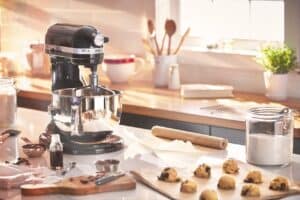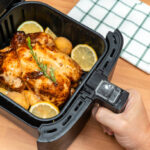
The accessories are attached to the beater shaft, and mix, stir, whip beat, and knead the ingredients in a work bowl. A stand mixer can make a few daunting baking or cooking manual tasks more enjoyable and entertaining. So, this gadget’s convenience has made it very popular in recent years.
However, this machine can become a “pricey decor” on your kitchen counter if you usually order food or buy ready one for microwaving and do not cook regularly at home. You will invest a lot of money into a hefty and large device that will occupy your kitchen space.
Read More: The Best Stand Mixers in 2023: What You Need To Know
However, suppose you are an avid baker, an enthusiastic cooker, or just passionate about cooking and do it regularly at home. In that case, the stand mixer is a significant investment that can save you a lot of cooking time and effort.
Yet, the stand mixer market consists of so many brands and models that it is not easy to select when you decide to buy one. One should consider several critical parameters when choosing the best stand mixer for your needs.
Table of Contents
Stand Mixer Size, Bowl Capacity, and Head Type
When you decide to buy a stand mixer, the most critical factor is what capacity of mixing bowl you need. The typical stand mixer for mixing bowl capacity ranges from 3.5 quarts to 7 quarts and more.
So, the small household will require a smaller bowl capacity of 3.5–4.5 quarts, while the larger household will benefit from the 5–6 quarts mixer bowl. And if you cook not only for your family but also for other people, you better consider the mixer capacity with a bowl of 7 or more quarts.
The mixing bowl size is directly connected to the construction of a stand mixer Head Type. The smaller capacity mixer is usually equipped with the Tilt-Head type, while the bigger mixer is constructed with the Bowl-Lift head type.
Tilt-Head
The tilt-head type has a bowl attached directly to the machine’s base, so the head tilts back and forward to allow access to the bowl and beater head when you need to add ingredients or change accessories. This type of stand mixer usually comes with a large bowl capacity ranging from 3.5–5 quarts.
Bowl-Lift
The stand mixers with bowl-lift construction have a bowl connected to two sturdy levers. A lever lifts the bowl to the appropriate position under the beaters shaft with an attached accessory. To add ingredients or change the accessories, the user will lift up or down the bowl to access it. These types of machines usually come with six and more quarts bowl capacity.
Tasks and Accessories
So, to select the suitable machine for you, first of all, you have to consider the kind of functions you will expect this kitchen appliance to perform and think if it will deliver the task you plan to use it for.
Essentially, there are two main types of stand mixers:
- The one that is designed to tackle the classic mixing, stirring, whipping, beating, and kneading job for typical baking and cooking tasks and uses the work bowl and standard attachments.
- The machines are designed for an extensive range of extra attachments and can perform various chores, including food processing tasks, juicing, blending, meat mincing, paralyzing veggies, etc.
Standard Attachments
The typical quality stand mixer must come with the following accessories for performing classic mixing, stirring, whipping, beating, and kneading tasks:
- A Beater — tool for mixing chores;
- A Dough Hook — attachment for the kneading task;
- A Balloon Whisk — accessory to perform whisking and whipping job;
A good stand mixer model may also include additional accessories such as:
- Flexi-beater — a beater with a supple spatula brink on the side, so it will be able to remove the sticky food from a bowl surface;
- Splashguard – a special bowl that stops the food in the bowl from splashing outside of the bowl;
- Additional larger or smaller bowl;
Extra Attachments
A few stand mixers come with a special knob that makes them compatible with a set of extra attachments such as a food processor, juicer, blender, pasta machine, meat grinder, and others. This special attachment transfers the device into a very versatile machine.
This extra attachment usually includes:
- Food processor accessories that will perform typical food processor jobs such as slicing, shredding;
- Blender, the device that will make smoothies, soups, and other small mixing jobs such as making sauces and dressings;
- A juicer that will extract good quality juice, the attachment usually comes in the form of a slow juicer;
- Grain Miller and Pasta Making attachment that will make all kinds of pasta;
- Meat grinder for burgers and sausages;
- Ice cream maker;
- Spiralizer that will produce veggies, spaghetti, and pasta;
- Vegetable sheet cutter;
- Sausage stuffer kit;
- Citrus juicer attachment;
Mixing Action
There are two primary types of beater shafts moving during the processing action.
A Circular Motion — the typical mixing action design, the mixer beater shaft is rotated around its radial axis.
A Planetary Motion - is the most advanced stand mixer construction when the beater shaft rotates in one direction. In contrast, the socket where the post is connected revolves in the opposite direction. The manufacturers insist that this motion action is more efficient, mixing better, and does not need the manual wall scrapping of the bowl.
The circular and planetary motion actions produce a similar result if their machine is powerful enough and the mixing bowl is big enough for the processed recipe.
Other Criteria to Pick Best Stand Mixer
Here are some of the less critical parameters you may consider while selecting the best stand mixer for you.
Cost
So your budget is crucial in choosing a stand mixer; you decide you want the best value for money or you like the best of the best.
Decent Stand Mixer costs from $70 to as high as $600. The price depends on the mixer’s brand, model, and size.
If you decide to buy the device manufactured by a reputable company with producing history, you will have to pay about $300 –$600 or more money for such a machine. On the other hand, if you go to the Chinese generic knock-off model, such a machine may start from $70.
The price of the mixer also depends on the capacity of the processing bawl. Indeed, the smaller mixer costs less than, the bigger versions of it.
Brand
In recent years, a large number of Chinese generic knock-off kitchen appliances are flooding the kitchen appliances market, and stand mixers are not an exclusion. So it is your choice if you want to choose a cheap Chinese knock-off that will most likely go out of order within a short time or you buy the machine for years to last and will perform as declared.
For example, Kitchenaid produces a range of the best stand mixers; it is the brand that invented this machine and has remained a leader in this market segment for many years.
Warranty and Customer Service
The warranty and customer support are essential parameters when buying an expensive and hefty machine. That means the manufacturer must be ready to resolve any problems with their product. The availability of the replacement part is also an essential criterion when you buy an expensive large appliance. In addition, the warranty indicates how much trust the manufacturer puts in their goods. So, a well-known and reputable company is expected to have better customer support and warranty than a company that retails Chinese knock-off models.
Noise
The noise that a typical Stand Mixer release varies and depends on the model and brand of your mixer and the task and food you perform. Still, on average Stand Mixer is likely to produce a noise level between 70 to 90 decibels (dB). It could be compared to the noise from a blender or vacuum cleaner. That means these gadgets are not particularly quietest machines; however, you can put noise dampening under the device during use, such as a towel or silicon pad.
Storage for Attachments
Stand Mixer is a large and heavy machine and comes with a few large accessories that must be stored somewhere. They usually take up a lot of storage space. So it is crucial to keep all the accessories in good order. So the model that comes with a convenient caddy for attachment is a plus that takes your storage place tidily.
Summary
The criteria mentioned above are the most important and should help you select a decent stand mixer that will satisfy your essential needs.
Read More: The Best Stand Mixers in 2023: What You Need To Know
Read More: Food Processor Buying Guide



